CHRO Trends 2020 Report

By Zac Upchurch, Chief Operating Officer, Talent Strategy Group
I am pleased to present the third edition of this Chief Human Resources Officer Report reviewing trends in the CHRO marketplace and introducing the thirty-six Fortune 200 Chief Human Resources Officers who came into the role in 2019.
Our analysis of the Chief Human Resources Officer draws enlightening trends:
- CHRO Turnover Increases: Over 19% of the Fortune 200 Chief Human Resources Officers turned over in 2019 representing a 16% higher turnover rate in 2019 versus 2018. A large contributor to the rising turnover rate for CHROs was the 40% increase in CEO turnover in 2019. The high correlation of CEO and CHRO turnover translates to an increase in CHRO turnover that we expect to continue into 2020.
- Internal Succession Continues to Decline: 2019 yielded the lowest rate of internal CHRO successors since this report’s inception with 53% of CHRO appointments coming from internal successors. If the declining trend of internal successors continues, external successors will overtake internal successors in 2020.
- Female CHROs are on the Rise: 78% of new CHROs in 2019 were female representing the largest class of female CHROs since this report’s inception. In the Fortune 200 overall, over two-thirds (67%) of CHROs are female, a 12% increase over 2018.
I wish to thank the contributors to this report and look forward to working with the new Chief Human Resources Officers of 2019 to advance the role of the CHRO and field of Human Resources in 2020 and beyond.
The Trends
The Fortune 200 welcomed 36 new Chief Human Resource Officers to the role in 2019. In total, these 36 new CHROs lead more than 4.3 million employees and oversee more than $2.2 trillion in annual revenue. Our analysis of the 36 new CHROs illuminates seven trends with implications for existing and aspiring CHROs.
Trend One: CHRO Turnover Increases
Chief Human Resources Officers realized a 16% higher turnover rate in 2019 than in 2018. Nearly one in five (19%) CHROs turned over in 2019 implying organizations replace their CHRO every 5.27 years.
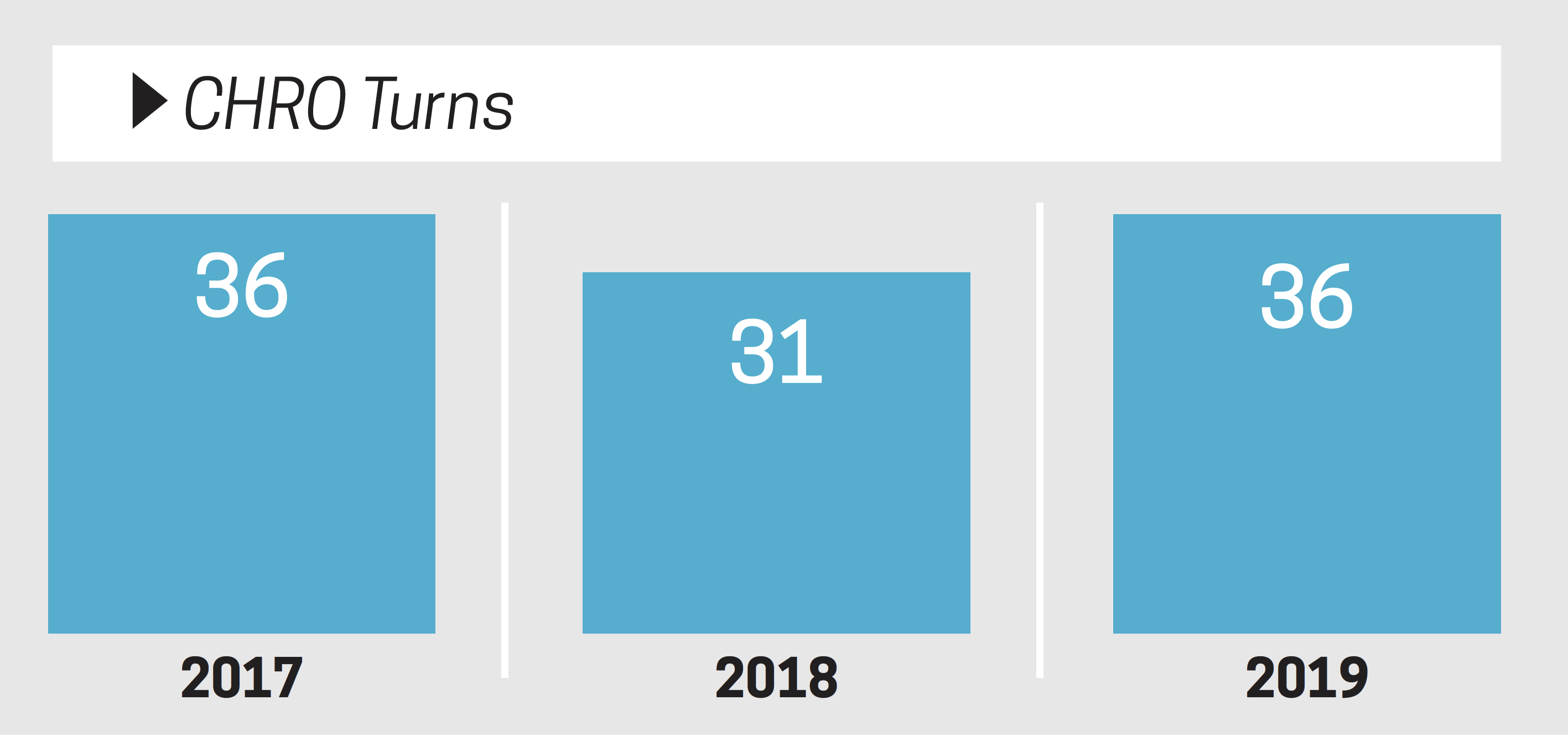
Larger revenue company CHROs were more likely to experience turnover than smaller revenue company CHROs. Within the Fortune 10 alone, there were 4 CHRO replacements. A CHRO in the Fortune 10 was over twice as likely to experience turnover in 2019 than the average Fortune 200 CHRO. A CHRO in the Fortune 50 was twice as likely to experience turnover than a Fortune 150-200 CHRO.
The Financial and Health Care sectors combined represented 39% of the CHRO moves in 2019 with seven (7) CHRO moves each. A CHRO in the Financial or Health Care sectors were 3.5 times more likely to experience turnover than a CHRO in other sectors.

Trend Two: CEO Turnover Drives CHRO Turnover
For the second year in a row, there is a high correlation between Chief Executive Officer and Chief Human Resources Officer turnover. 2019 was a significant year for CEO turnover with a 40% increase in CEO turnover compared to 2018. This increase in CEO turnover resulted in a larger turnover for the CHRO role. Of the thirty-five new CEOs who came into the role in 2019, 40% have replaced their Chief Human Resources Officer.
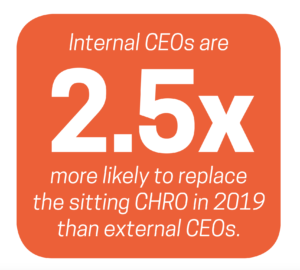
An internal CEO successor was 2.5 times more likely to replace the sitting CHRO in 2019 than an external CEO successor. When replacing the CHRO, an internal CEO successor was more likely to look from within the company than an external CEO successor. An internal CEO replaced the sitting CHRO with an internal CHRO successor 64% of the time while an external CEO replaced the sitting CHRO with an internal CHRO successor only 33% of the time.
Trend Three: Internal CHRO Succession Declines
Internal successors represent a majority (53%) of new CHROs in 2019. However, there has been a steady decline in the selection of internal successors for the Chief Human Resources Officer role in the Fortune 200. In 2017, 70% of CHROs were internal successors compared to 61% in 2018 and 53% in 2019. If the trendline continues to decline into 2020, it’d suggest a majority of new CHROs will be external successors for the first time since this report’s inception.
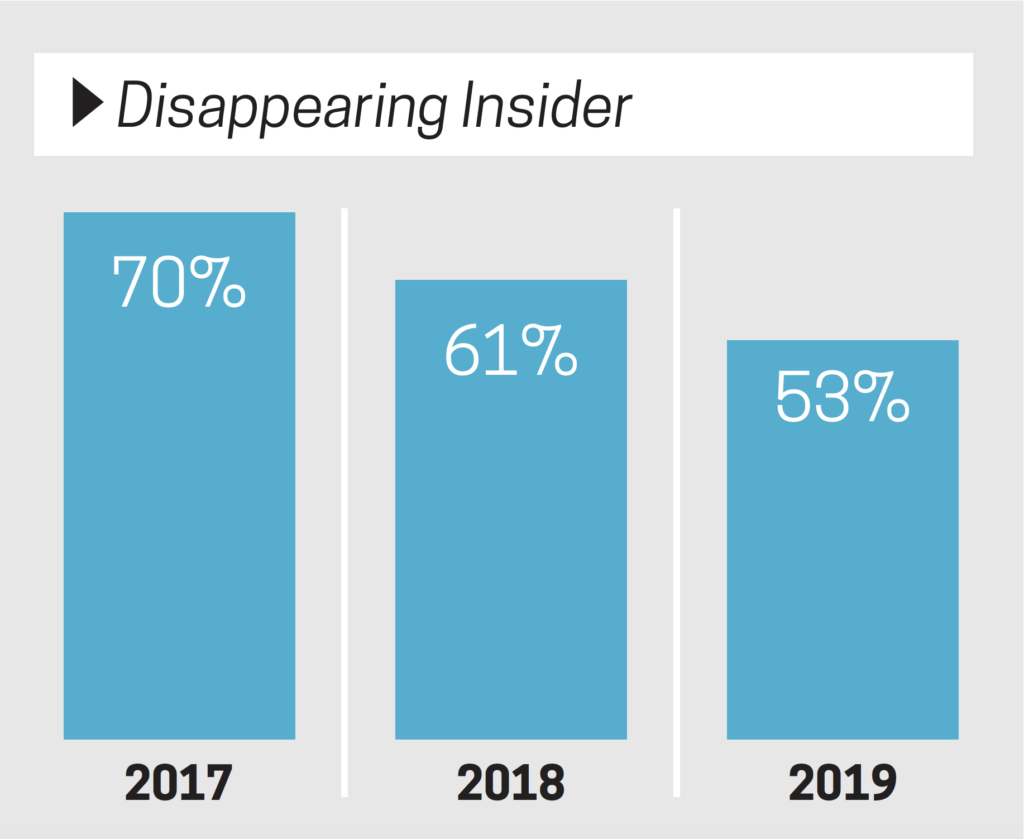
The pathway for a first-time CHRO role still predominantly flows through internal succession with 85% of first-time CHROs coming to the role through internal succession. For internal successors, tenure within their organization still reigns supreme. Two-thirds of internal successors had 15 or more years of tenure within their company before promotion to the Chief Human Resources Officer role.
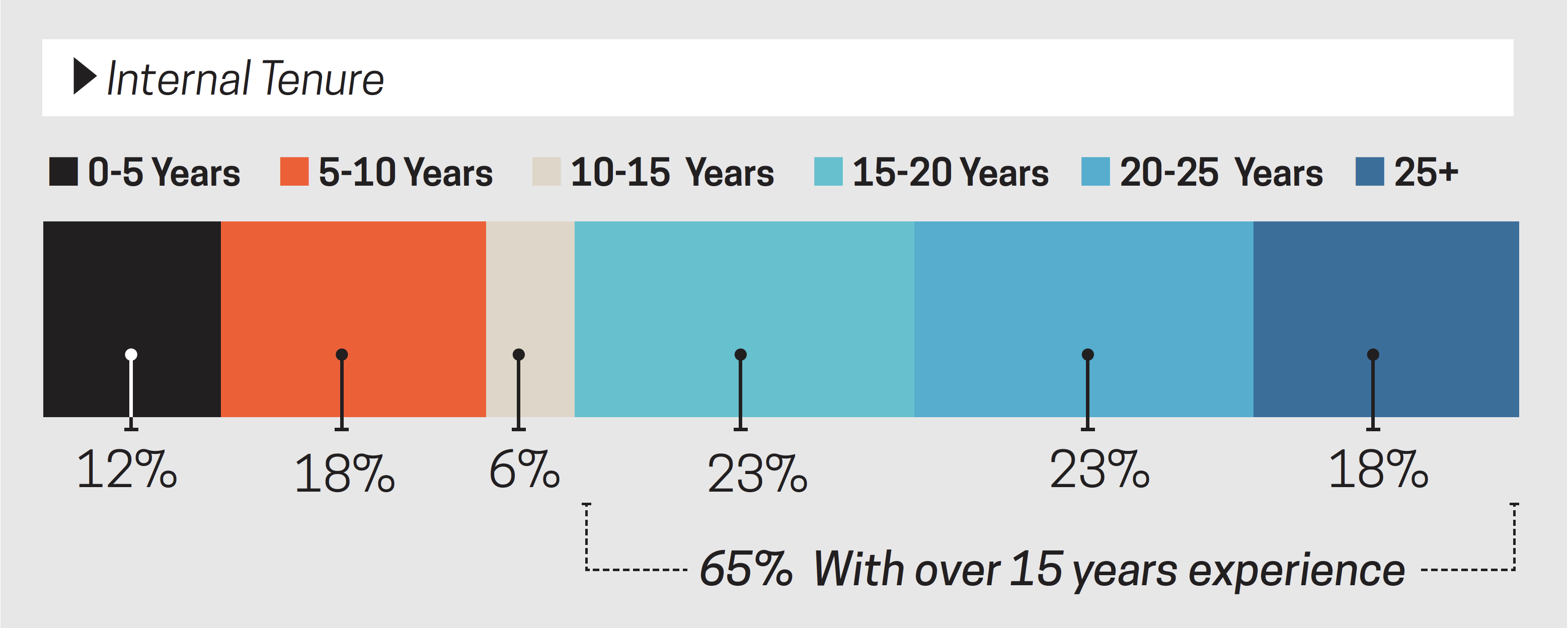
For external successors, previous experience in the Chief Human Resources role is critical. When a company went external for a Chief Human Resources Officer, the vast majority (82%) of the time the company selected an individual currently serving as a CHRO. This reliance on previous CHRO expertise has created a secondary market for sitting CHROs to increase the size and scope of their role. In 100% of external successor cases, the CHRO transferred to a company that was larger than its predecessor company.
Trend Four: The CHRO’s Second Act
There have been a number of high-profile succession plans play out in 2019 and the beginning of 2020 for the Chief Executive Officer role. With these succession plans, there is the emergence of the CEO’s “second act” as an internal Executive Chairman. Such CEO successions include Mark Parker (Nike), Bob Iger (the Walt Disney Company), and Ajay Banga (Mastercard). The internal Executive Chairman role allows the CEO to relinquish some operational control while protecting their strategy and legacy.
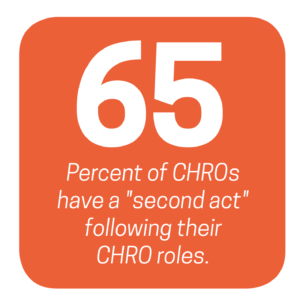
So, too, is the case for Chief Human Resources Officers. An analysis of the predecessors to the new Class of 2019 CHROs yielded that CHROs have a “second act” after serving as a CHRO. While 35% of the departing CHROs outright retired, 31% of the departing CHROs took on a new or bigger role within the company – most notably a Chief Administration Officer role or Advisor to the CEO role. An additional 12% took a lateral move into a business role. The remaining are actively searching for their “second act” or serve as consultants.
Trend Five: Female CHROs On The Rise
While the CEO role in the Fortune 200 saw a decline in female representation, Human Resources continued to see an insurgence of female Chief Human Resources Officers. Over three-fourths (78%) of the new CHROs in 2019 were female. This figure represents the largest percentage of female CHROs since this report’s inception.
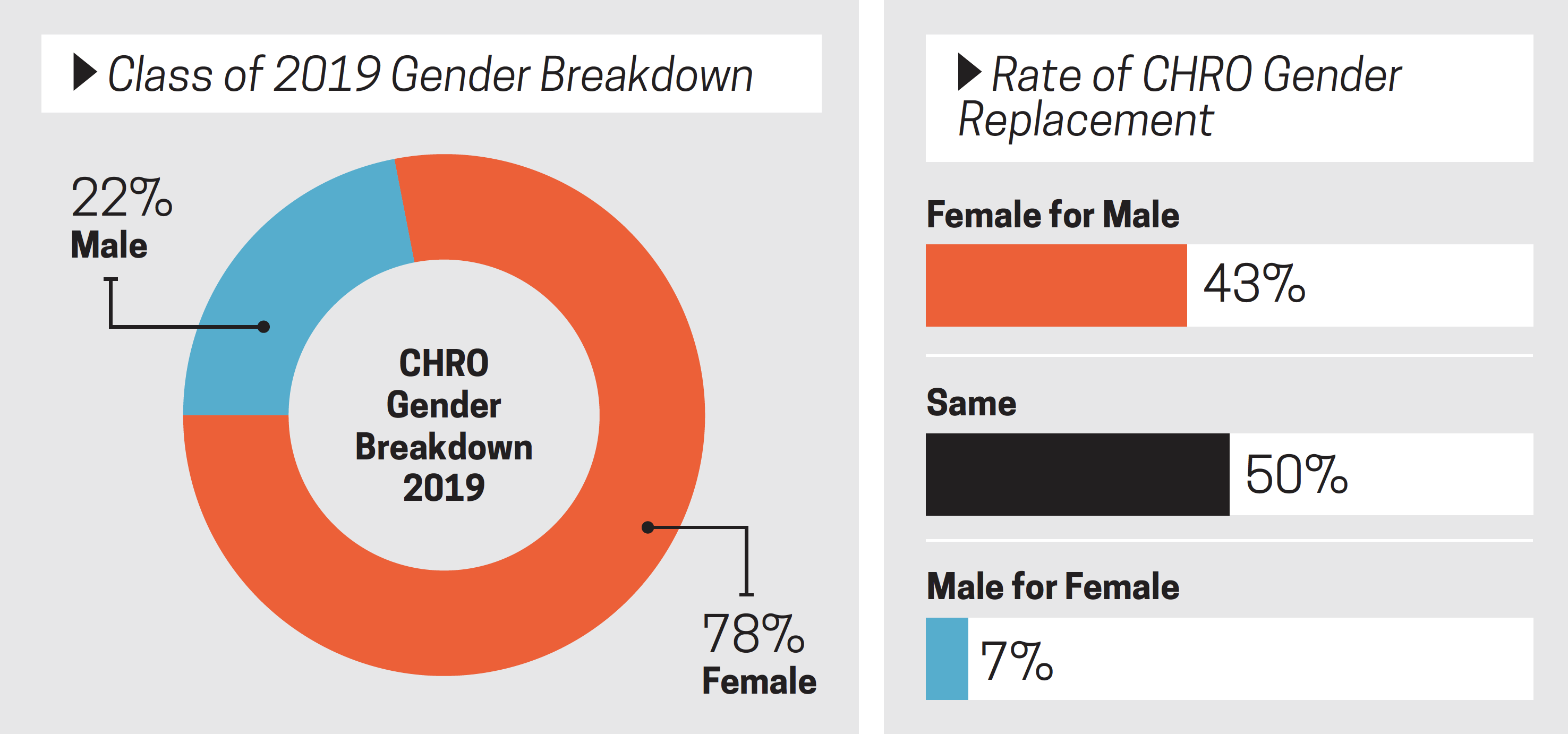
From 2018 to 2019 alone, female representation in the Fortune 200 role increased 12% from 60% to 67.3% overall. This increase is largely due to a number of outgoing male CHROs being replaced with female CHROs in 2019. Of the outgoing CHROs, 50% were replaced with a person of the same gender (male for male or female for female), 43% saw a female replace a male CHRO, and just 7% saw a female CHRO replaced by a male CHRO.

Trend Six: Human Resources Experience Dominates
Over four out of five (83%) of new CHROs had significant domain experience in Human Resources before taking on the top role in Human Resources. Still, 17% of Chief Human Resources Officers come into the role with limited to no domain expertise in Human Resources. This percentage is statistically unchanged from 2017 where 20% of new CHROs came into the role with limited or no Human Resources domain expertise.
An external CEO successor is less likely to appoint a Chief Human Resources Officer with limited to no experience in the domain. The vast majority (88%) of CHROs appointed with limited to no experience in Human Resources were appointed by internal CEO successors.
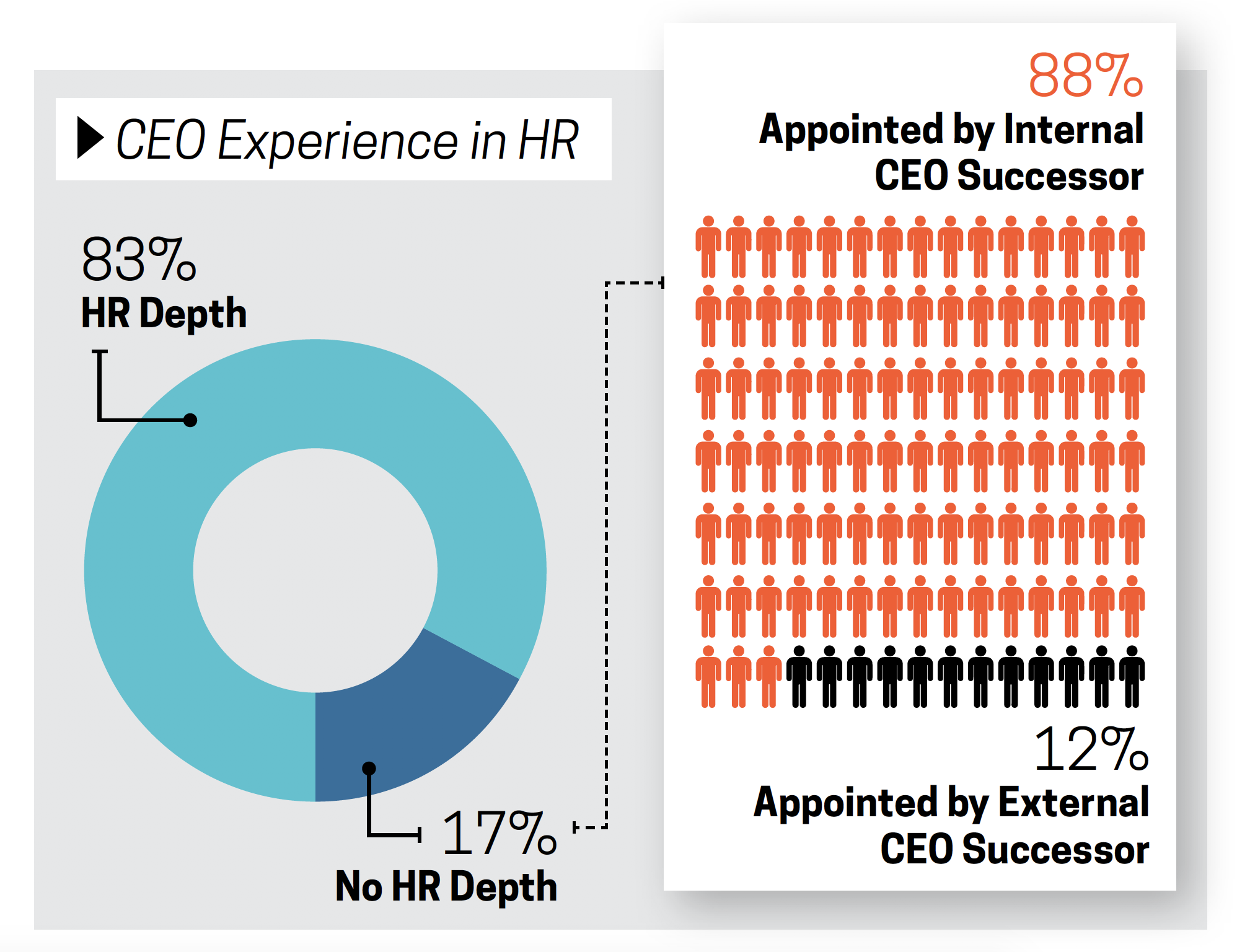
Trend Seven: Advanced Education Is Prevalent
100% of the new CHROs of 2019 obtained a bachelor’s degree or equivalent. Advanced degrees were 35% more common in 2019 than 2018 with 65% of Chief Human Resources Officers holding one or multiple advanced degrees. Of CHROs with an advanced degree, 86% held a master’s degree or equivalent and 22% held a legal degree (JD).

The New 2019 CHROs
In conversation with various members of the 2019 CHROs, issues on top of the CHRO agenda include the attraction and retention of top talent, increasing HR and managerial accountability and capability, and navigating the paradox of maximizing for today versus investment in tomorrow to drive enduring business results. An overview of the top issues facing these CHROs include:
Attraction and Retention of Top Talent: The focus on top talent is greater than ever. The United States (and more generally, the world) is sustaining one of history’s longest bull markets. With this bullish macroeconomic environment comes an increased demand for talent as companies compete for more than their fair share of exceptional talent. According to the Conference Board in their C-Suite Challenge, a primary internal stressor for senior executives is the attraction and retention of top talent. The 2019 CHROs view the attraction and retention of top talent as the primary priority for their first year(s) in office. In fact, many went so far as to brand themselves as talent-first Chief Human Resources Officers.
Build/Evolve HR and Manager Capability and Accountability: After an initial audit of their HR organization, many of the 2019 CHROs lamented that their HR processes and technology, while often complex, were sufficient. However, Human Resources and managerial capability and accountability left much to be desired. The new CHROs of 2019 outlined aspirations to assign hard accountabilities for HR practices to HR and managers. In addition, these CHROs reflected on a desire to build capability in HR and managers at scale to meet the increased HR standards. For HR, this means creating an impactful HR Operating Model with a shift towards more strategic HR team members and HRBPs. For managers, this means building capability around foundational elements like setting goals, providing performance-enhancing feedback and coaching, and developing successors.
Managing Paradox – Maximizing for Today versus Investing in Innovation for the Future: The vast majority of 2019 CHROs we spoke with used the word “disruptive” to describe their current business environment (or that disruption was imminent) – disruption from new competitors, technologies and AI, economies (market cycles and political instabilities), generational changes, different ways of working. And with the bull market, the expectation shareholders have for exceptional short-term results is magnified. For these 2019 CHROs, a key concern is in balancing operational excellence and efficiency of today with the investment in emerging capabilities and business models that maintain or increase the market share of their business in the disruptive world of tomorrow.
About the Research
We produced this information by analyzing the Fortune 200 organizations (based on the 2019 Fortune 500 list) and publicly available information for Chief Executive Officers and Chief Human Resources Officers. We additionally spoke with many Chief Human Resources Officers and their teams within the Fortune 200 to validate data where publicly available information was not available.
In total, 190 organizations had a sitting, identifiable CHRO at the time of this report. The trends above highlight those 190 organizations of the Fortune 200. Some organizations, such as Berkshire Hathaway, do not have a sitting Chief Human Resources Officer. In those situations, we did not include the company in the analysis.
More About The Author:
- Zac Upchurch, Chief Operating Officer, Talent Strategy Group
- Zac joined the Talent Strategy Group in 2016 and now directs the daily operations of the firm, including strategy, planning, and finance, across all of TSG businesses. Zac also leads the firm’s relationships with premier clients globally and consults with select clients worldwide.